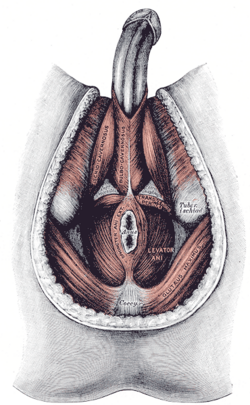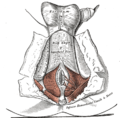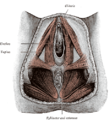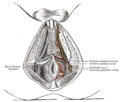Perineum: Difference between revisions
Darrenhusted (talk | contribs) m ? |
→Additional images: Restore image removed without discussion |
||
| Line 84: | Line 84: | ||
Image:Gray1077.png|The posterior aspect of the rectum exposed by removing the lower part of the sacrum and the coccyx. |
Image:Gray1077.png|The posterior aspect of the rectum exposed by removing the lower part of the sacrum and the coccyx. |
||
Image:Gray1119.png|Stages in the development of the external sexual organs in the male and female. |
Image:Gray1119.png|Stages in the development of the external sexual organs in the male and female. |
||
Image:The Taint by David Shankbone.jpg|Photograph of the male perineum. |
|||
</gallery> |
</gallery> |
||
Revision as of 06:19, 6 July 2008
It has been suggested that Taint (slang) and Talk:Perineum#Merger proposal be merged into this article. (Discuss) Proposed since January 2008. |
| Perineum | |
|---|---|
 The muscles of the male perineum | |
| Details | |
| Artery | perineal artery, dorsal artery of the penis, deep artery of the penis |
| Nerve | perineal nerve, posterior scrotal nerves, dorsal nerve of the penis, dorsal nerve of clitoris |
| Lymph | primarily superficial inguinal lymph nodes |
| Identifiers | |
| MeSH | D010502 |
| TA98 | A09.5.00.001 |
| TA2 | 131 |
| FMA | 9579 |
| Anatomical terminology | |
In human anatomy, the perineum is generally defined as the surface region in both males and females between the pubic symphysis and the coccyx. The perineum is the region of the body inferior to the pelvic diaphragm and between the legs.
A diamond-shaped area on the inferior surface of the trunk which includes the anus and, in females, the vagina[1]. Its definition varies: it can refer to only the superficial structures in this region, or it can be used to include both superficial and deep structures.
The perineum corresponds to the outlet of the pelvis.
The anogenital distance is a measure of male feminisation measuring the distance between the anus and the base of the penis. Studies show that the perineum is twice as long in males as in females. [2] Measuring the anogenital distance in neonatal humans has been suggested as a noninvasive method to predict neonatal and adult reproductive disorders.[3]
Boundaries
Its deep boundaries are as follows:[4]
- in front: the pubic arch and the arcuate ligament of the pubis
- behind: the tip of the coccyx
- on either side: the inferior rami of the pubis and Ischium, and the sacrotuberous ligament
In Alfred Kinsey's 1967 report, he concluded that the perineum was one of the 6 key erogenous zones for males.
Triangles
A line drawn transversely across in front of the ischial tuberosities divides the space into two triangles:
| Name | Location | Contents |
| Urogenital triangle | the anterior triangle | in females, contains the vagina |
| Anal triangle | the posterior triangle | contains the anus |
Perineal fascia
The terminology of the perineal fascia can be confusing, and there is some controversy over the nomenclature. This stems from the fact that there are two parts to the fascia, the superficial and deep parts, and each of these can be subdivided into superficial and deep parts.
The layers and contents are as follows, from superficial to deep:
- 1) Skin
- 2) superficial perineal fascia: Subcutaneous tissue divided into two layers: (a) A superficial fatty layer, and (b) Colles' fascia, a deeper, membranous layer.
- 3) deep perineal fascia and muscles:
| superficial perineal pouch | Contains superficial perineal muscles: transversus perinei superficialis, bulbospongiosus, ischiocavernosus |
| inferior fascia of urogenital diaphragm, or perineal membrane | A membranous layer of the deep fascia. |
| deep perineal pouch | Contains the deep perineal muscles: transversus perinei profundus, sphincter urethrae membranaceae |
| superior fascia of the urogenital diaphragm | Considered hypothetical by some modern anatomists, but still commonly used to logically divide the contents of the region. |
- 4) fascia and muscles of pelvic floor (levator ani, coccygeus)
Areas of the perineum
The region of the perineum can be considered a distinct area from pelvic cavity, with the two regions separated by the pelvic diaphragm. The following areas are thus classified as parts of the perineal region:
- perineal pouches: superficial and deep (see above for details)
- Ischioanal fossa - a fat filled space at the lateral sides of anal canal. It is bounded laterally by obturator internus muscle, medially by pelvic diaphragm and anal canal. Its base is the skin.
- Anal canal
- Pudendal canal - contains internal pudendal artery and the pudendal nerve.
Additional images
-
Diameters of inferior aperture of lesser pelvis (female).
-
The perineum. The integument and superficial layer of superficial fascia reflected.
-
Muscles of the female perineum.
-
The superficial branches of the internal pudendal artery.
-
The posterior aspect of the rectum exposed by removing the lower part of the sacrum and the coccyx.
-
Stages in the development of the external sexual organs in the male and female.
-
Photograph of the male perineum.
References
- ^ Gray, Henry. Anatomy of the Human Body. Philadelphia: Lea & Febiger, 1918; Bartleby.com, 2000.
- ^ Validity of anogenital distance as a marker of in utero phthalate exposure. PMID 16393642
- ^ Michelle Welsh, et al.: Identification in rats of a programming window for reproductive tract masculinization, disruption of which leads to hypospadias and cryptorchidism. J. Clin. Invest., 13 March 2008.
- ^ perineumboundaries
See also
External links
- perineum at The Anatomy Lesson by Wesley Norman (Georgetown University)







